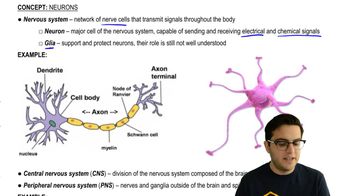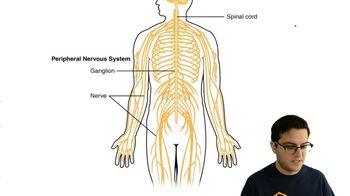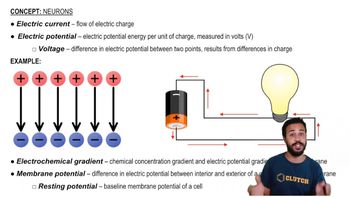Table of contents
- 1. Introduction to Biology2h 42m
- 2. Chemistry3h 40m
- 3. Water1h 26m
- 4. Biomolecules2h 23m
- 5. Cell Components2h 26m
- 6. The Membrane2h 31m
- 7. Energy and Metabolism2h 0m
- 8. Respiration2h 40m
- 9. Photosynthesis2h 49m
- 10. Cell Signaling59m
- 11. Cell Division2h 47m
- 12. Meiosis2h 0m
- 13. Mendelian Genetics4h 44m
- Introduction to Mendel's Experiments7m
- Genotype vs. Phenotype17m
- Punnett Squares13m
- Mendel's Experiments26m
- Mendel's Laws18m
- Monohybrid Crosses19m
- Test Crosses14m
- Dihybrid Crosses20m
- Punnett Square Probability26m
- Incomplete Dominance vs. Codominance20m
- Epistasis7m
- Non-Mendelian Genetics12m
- Pedigrees6m
- Autosomal Inheritance21m
- Sex-Linked Inheritance43m
- X-Inactivation9m
- 14. DNA Synthesis2h 27m
- 15. Gene Expression3h 20m
- 16. Regulation of Expression3h 31m
- Introduction to Regulation of Gene Expression13m
- Prokaryotic Gene Regulation via Operons27m
- The Lac Operon21m
- Glucose's Impact on Lac Operon25m
- The Trp Operon20m
- Review of the Lac Operon & Trp Operon11m
- Introduction to Eukaryotic Gene Regulation9m
- Eukaryotic Chromatin Modifications16m
- Eukaryotic Transcriptional Control22m
- Eukaryotic Post-Transcriptional Regulation28m
- Eukaryotic Post-Translational Regulation13m
- 17. Viruses37m
- 18. Biotechnology2h 58m
- 19. Genomics17m
- 20. Development1h 5m
- 21. Evolution3h 1m
- 22. Evolution of Populations3h 52m
- 23. Speciation1h 37m
- 24. History of Life on Earth2h 6m
- 25. Phylogeny2h 31m
- 26. Prokaryotes4h 59m
- 27. Protists1h 12m
- 28. Plants1h 22m
- 29. Fungi36m
- 30. Overview of Animals34m
- 31. Invertebrates1h 2m
- 32. Vertebrates50m
- 33. Plant Anatomy1h 3m
- 34. Vascular Plant Transport1h 2m
- 35. Soil37m
- 36. Plant Reproduction47m
- 37. Plant Sensation and Response1h 9m
- 38. Animal Form and Function1h 19m
- 39. Digestive System1h 10m
- 40. Circulatory System1h 57m
- 41. Immune System1h 12m
- 42. Osmoregulation and Excretion50m
- 43. Endocrine System1h 4m
- 44. Animal Reproduction1h 2m
- 45. Nervous System1h 55m
- 46. Sensory Systems46m
- 47. Muscle Systems23m
- 48. Ecology3h 11m
- Introduction to Ecology20m
- Biogeography14m
- Earth's Climate Patterns50m
- Introduction to Terrestrial Biomes10m
- Terrestrial Biomes: Near Equator13m
- Terrestrial Biomes: Temperate Regions10m
- Terrestrial Biomes: Northern Regions15m
- Introduction to Aquatic Biomes27m
- Freshwater Aquatic Biomes14m
- Marine Aquatic Biomes13m
- 49. Animal Behavior28m
- 50. Population Ecology3h 41m
- Introduction to Population Ecology28m
- Population Sampling Methods23m
- Life History12m
- Population Demography17m
- Factors Limiting Population Growth14m
- Introduction to Population Growth Models22m
- Linear Population Growth6m
- Exponential Population Growth29m
- Logistic Population Growth32m
- r/K Selection10m
- The Human Population22m
- 51. Community Ecology2h 46m
- Introduction to Community Ecology2m
- Introduction to Community Interactions9m
- Community Interactions: Competition (-/-)38m
- Community Interactions: Exploitation (+/-)23m
- Community Interactions: Mutualism (+/+) & Commensalism (+/0)9m
- Community Structure35m
- Community Dynamics26m
- Geographic Impact on Communities21m
- 52. Ecosystems2h 36m
- 53. Conservation Biology24m
45. Nervous System
Neurons and Action Potentials
Problem 14d`
Textbook Question
Certain species of frogs in the genus Phyllobates have a powerful defensive adaptation—their skin can secrete a milky fluid that contains an extremely toxic compound called batrachotoxin (BTX). These frogs, which are found in Colombia, are known as poison dart frogs because some indigenous Colombian hunters coat the tips of their blowgun darts with the frogs' skin secretions. An animal hit by one of these darts dies quickly.
What is the mechanism of action of BTX?
Like neurons, cells in skeletal and cardiac muscle also produce action potentials. Create a concept map showing how BTX could kill a mammal through its effects on nervous and muscle tissues.
 Verified step by step guidance
Verified step by step guidance1
Begin by understanding the basic function of batrachotoxin (BTX). BTX is a potent toxin that affects the nervous system by altering the function of sodium channels in cell membranes.
Next, explore how sodium channels work. Sodium channels are essential for the generation and propagation of action potentials in neurons and muscle cells. They open in response to a change in voltage across the cell membrane, allowing sodium ions to flow into the cell, which is crucial for the depolarization phase of the action potential.
Consider the effect of BTX on sodium channels. BTX binds to and keeps sodium channels open, preventing them from closing. This leads to a continuous influx of sodium ions, disrupting the normal action potential cycle and causing prolonged depolarization.
Examine the consequences of prolonged depolarization in neurons and muscle cells. In neurons, this can lead to uncontrolled firing and eventually neuronal death. In muscle cells, particularly in cardiac muscle, it can cause arrhythmias or cardiac arrest due to the inability to properly regulate contraction.
Finally, create a concept map that links BTX's action on sodium channels to its lethal effects. Include nodes for BTX, sodium channels, action potentials, neurons, muscle cells, and the physiological outcomes such as arrhythmias and neuronal death. Connect these nodes to illustrate the pathway from BTX exposure to the toxic effects on the organism.
 Verified video answer for a similar problem:
Verified video answer for a similar problem:This video solution was recommended by our tutors as helpful for the problem above
Video duration:
59sPlay a video:
Was this helpful?
Key Concepts
Here are the essential concepts you must grasp in order to answer the question correctly.
Batrachotoxin (BTX)
Batrachotoxin is a potent toxin found in certain species of poison dart frogs. It works by binding to voltage-gated sodium channels in nerve and muscle cells, preventing them from closing. This leads to continuous depolarization, disrupting normal cellular function and causing paralysis or death due to the inability to generate action potentials properly.
Action Potentials
Action potentials are rapid electrical signals that travel along the membrane of neurons and muscle cells. They are essential for communication within the nervous system and for muscle contraction. The process involves the opening and closing of ion channels, particularly sodium and potassium channels, which create a wave of depolarization followed by repolarization.
Recommended video:
Guided course
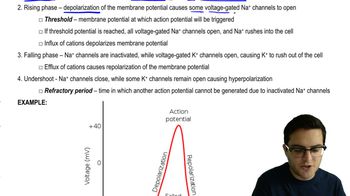
Action Potential
Voltage-Gated Sodium Channels
Voltage-gated sodium channels are crucial for the initiation and propagation of action potentials in neurons and muscle cells. These channels open in response to changes in membrane potential, allowing sodium ions to flow into the cell, leading to depolarization. BTX disrupts this process by keeping these channels open, causing continuous depolarization and preventing normal cellular function.
Recommended video:
Guided course
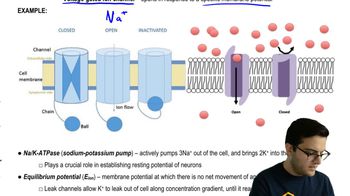
Ion Channels and Pumps
Related Videos
Related Practice



